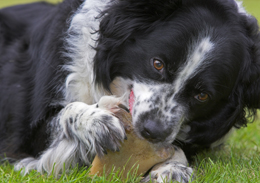Using Safe Scenarios: The case of the Biting Border Collie
 Finn was a happy, healthy, super-fit, 2-year old Border Collie and for the most part he was a well behaved dog. But he had one problem. Finn had a habit of snapping at the hands and feet of strangers.
Finn was a happy, healthy, super-fit, 2-year old Border Collie and for the most part he was a well behaved dog. But he had one problem. Finn had a habit of snapping at the hands and feet of strangers.
The people at the shelter said’ “Give him enough quality exercise and the problem will probably go away”. As his new owners were avid runners it looked like a perfect match, and it should have worked out just fine. Except that it didn’t. The behavior continued and Finn even started to display the same behavior in public.
It wasn’t that he was clamping down in a proper bite, or breaking skin, he would only snap and recoil quickly. But this was still a serious problem that could escalate if not dealt with urgently and appropriately.
The first thing we recommended to Finn's owners was that they begin using the Alpha Techniques as per the Secrets to Becoming the Alpha Dog bonus ebook included in the Secrets to Dog Training download package. It was very important for Finn's owners to teach Finn that they were above him in the pack hierarchy, so that he was consistently responsive to their commands and corrections. They were also urged to begin regular obedience training sessions with Finn to improve their control over him in all situations.
The owners were told to stage 'safe scenarios' where this behavior could be displayed and corrected on the spot.
Staging safe scenarios
Staging safe scenarios is an excellent way to desensitize dogs to things they are reacting inappropriately too. They allow you to show your dog which behaviors are acceptable in a certain situation and which behaviors are not. The idea is to recreate the situation in which the dog is behaving incorrectly, but in such a way that you are in full control of the dog and can show it the expected behavior without risking the safety of yourself, other people or other animals.
The Equipment
1. A Gentle Leader® or Halti® head harness. This gives you full control over the dog’s behavior.
2. A muzzle. This is necessary in the short term where people in the scenario may otherwise be at risk of being bitten.
3. A water bottle or can of pebbles
4. Any other equipment you may need to recreate the situation where your dog is behaving inappropriately. For example if your dog barks at bicycles you will need a bicycle.
The Procedure
The procedure will obviously differ depending on what situation you are working with. Gently expose the dog to the situation it is behaving incorrectly in and when it reacts inappropriately you immediately use the alarm-no-command method to stop the behavior and replace it with an appropriate one. In Finn’s case the procedure was set up as follows:
The dog had the muzzle and head collar put on with a leashed attached to the head collar and a person known to the dog handling the leash, leaving it loose and relaxed. The dog was then asked to go into a “down” position, praised and then told to “stay”. The dog was gently praised for remaining in the “down stay” to reinforce the behavior.
With the muzzled dog settled by a "down" command, the stranger was introduced to the scene, and when the dog responded as expected, the owner delivered a harsh "AH!", shook the can of pebbles or sprayed the dog with the water bottle (avoiding the face) and then the dog was told to return to the “down” position. Timing was everything. When the dog returned to a settled “down”, he was warmly praised.
Safe scenarios like this are effective because the dog soon learns to chose the appropriate behavior because it is more beneficial to it, basically focusing on you and your praise becomes more rewarding that worrying about the visitor, bike or other object you are working with. Safe scenarios could take many repetitions and should be repeated in short sessions as often as possible until your dog is consistently calm and behaves appropriately. This may take several weeks but it is well worth the effort.
In his case Finn got the point fairly quickly and learned good behavior. His owners were firm and consistent, and continued to use the Alpha Techniques and obedience training even after the nipping problem had been resolved.
All the best,
![]()
Daniel Stevens and the Secrets to Dog Training Team
"Secrets to Dog Training - STOP Dog Behavior Problems!"
http://www.kingdomofpets.com/dogobediencetraining/
P.S. Forward this Newsletter to a friend
If you have a friend you think may be interested in training their dog or solving a particular dog behavior problem, please feel free to forward them this Newsletter.
P.P.S. Remember – you have full access to our Members’ Forum
Because you are a Member of ‘Secrets to Dog Training’ you have full access to our Members’ Forum. If you have a dog behavior question or a related problem, you are most welcome to bring it to the Forum. Post a detailed description for our trainers and fellow Members to read. Within 1-4 working days you will see recommendations on how to solve it once and for all.
If you haven’t already registered for the Forum, you can do this from the Members’ Area: http://www.kingdomofpets.com/dogobediencetraining/members/ or you can go straight there by clicking here – http://www.kingdomofpets.com/dog/forum/
Previous Newsletters
